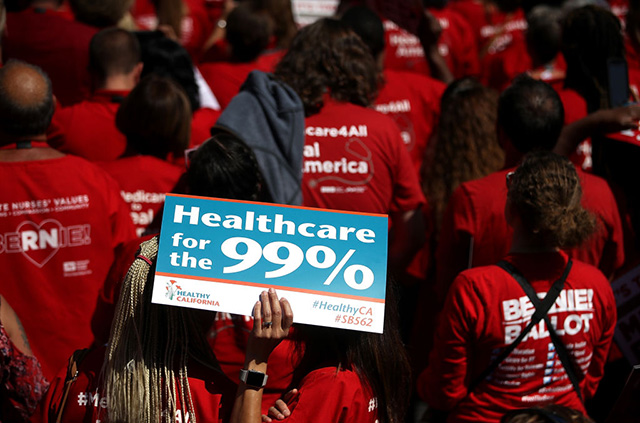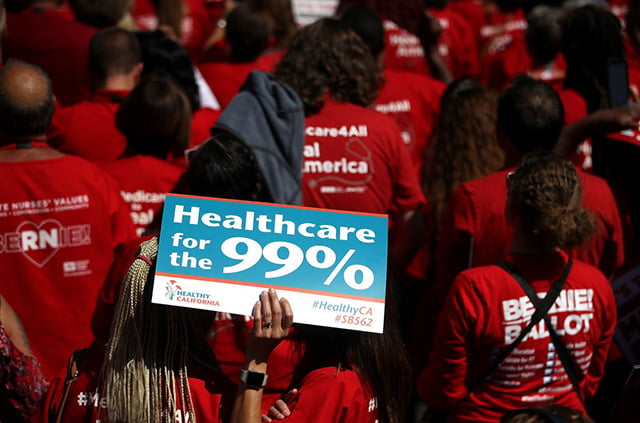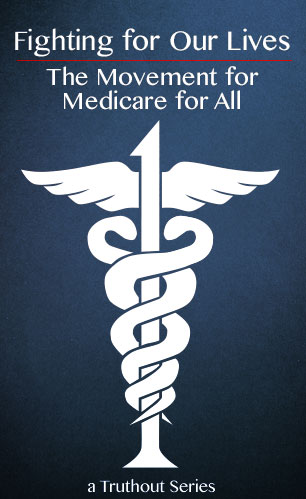
Part of the Series
Fighting for Our Lives: The Movement for Medicare for All
 Supporters hold signs as Sen. Bernie Sanders speaks about his Medicare for All Act during a health care rally at the 2017 Convention of the California Nurses Association/National Nurses Organizing Committee on September 22, 2017, in San Francisco, California. (Photo: Justin Sullivan / Getty Images)
Supporters hold signs as Sen. Bernie Sanders speaks about his Medicare for All Act during a health care rally at the 2017 Convention of the California Nurses Association/National Nurses Organizing Committee on September 22, 2017, in San Francisco, California. (Photo: Justin Sullivan / Getty Images)
This piece is part of Fighting for Our Lives: The Movement for Medicare for All, a Truthout original series.
Health care is a priority issue right now for many Americans, as President Trump and Republicans in Congress move to destroy Obamacare, Medicaid, the Children’s Health Insurance Program (CHIP) — and soon, even Medicare.
 When it comes to electoral politics, most voters’ attention is almost totally focused on the 2020 presidential election. However, given the urgency of the health care issue, the more logical date for an electoral push around single-payer is 2018. It’s closer, and it’s a time when a long list of challengers has the potential to transform the makeup of Congress.
When it comes to electoral politics, most voters’ attention is almost totally focused on the 2020 presidential election. However, given the urgency of the health care issue, the more logical date for an electoral push around single-payer is 2018. It’s closer, and it’s a time when a long list of challengers has the potential to transform the makeup of Congress.
Single-payer has had name recognition from coast to coast since 2003, and “universal health care” since Franklin Roosevelt was president. A July poll shows that 62 percent of Americans believe it is the government’s job to provide health care.
Will Congress ever act on the public’s demand for single-payer healthcare (aka Medicare for All)? It has everything to do with who’s going to be in the new Congress.
Monumental 2018 Midterm Turnout Predicted on Single-Payer
In next year’s midterms, the Medicare for All issue could rouse monumental, historic voter turnouts for candidates — challengers and incumbents — if they make its passage a priority issue on the campaign trail from now until November 2018.
First, count the millions of potential voters enrolled in federal healthcare programs. Some 12.2 million people are enrolled in Obamacare, 72.3 million in Medicaid, at least 6 million in CHIP and 58 million in Medicare. Medicare experiences an increase of 10,000 new recipients every day.
Next, add those not in federal programs. That’s the 28.2 million uninsured (aged 18-64), and their families and friends, prior to Trump’s becoming president and the 3.5 million since then. If the Republican-dominated Congress’s bills designed to end those programs — and Trump’s threats — have infuriated recipients enough, the total is a mighty potential voting bloc of 180 million — not even including those terrified they’ll lose their coverage in the next few months or if they’re disenfranchised by gerrymandering or bias.
They have every reason to vote for candidates endorsing Medicare for All in the midterms.
This is especially true given that, this year, Republicans have demonstrated that they are very serious about their goal of doing away with vital health care. Recent Republican bills have attempted to destroy Obamacare and Medicaid and hand the savings over to the 1 percent as tax cuts. Meanwhile, the Republican-pushed budget would cut Medicare by $500 billion, raising eligibility to 67, and shifting to a privatized voucher program.
A harbinger of what’s ahead has been this year’s explosive Republican town-hall meetings, dominated by health care and seen by the nation on YouTube. Thousands have watched Idaho Republican Raúl R. Labrador earn howls and boos last May when he declared: “Nobody dies because they don’t have access to health care.”
Nearly 350,000 have seen Iowa’s Sen. Joni Ernst draw jeers and chants of “Your Last Term!” when she told an uninsured 60-year-old to enroll in a health savings account.
Republican meetings have been packed by the fearful and ferocious coming out by the hundreds to blast their lawmakers’ efforts to end their federal coverage. Especially unnerving to incumbents have been the chants (“Single-Payer! Single-Payer!”), picket signs (“Shame on You!”) and pointed criticism from 50- and 60-somethings unable to afford post-job private coverage or healthcare savings accounts to cover catastrophic ailments, injuries or long-term care.
The word spread so swiftly that 175 members of Congress — 148 Republicans — abruptly decided not to stage town halls. That reinforces conclusions that image-saving and campaign donors from the health care industry and Big Pharma are more important than constituents.
On the other hand, such savage treatment on the hustings may well convince many fence-sitting Senate and House incumbents that the better part of valor in the upcoming contests is to make Medicare for All a No.1 priority and follow up in Congress. Rep. Earl Blumenauer (D-Oregon) for one, opposed single-payer up to this year before becoming one of the 120 co-sponsors of Rep. John Conyers’s HR 676 (Expanded and Improved Medicare-for-All Act).
To bolster turnout in 2018 by this significant electorate, activists are bound to keep after lawmakers at town halls and candidate rallies. And they may use videos of the thousands driving or walking miles to the free health care clinics in West Virginia, or the shocking visual coverage of the makeshift clinic in Wise, Virginia. They’re graphic signs of what’s to come in the US without single-payer health care.
Thus far, the Republicans’ health care repeal bills have all failed because of Republican defections. This indicates the power of action: The voices of constituents are being heard. Of course, it’s only a temporary reprieve, and it doesn’t apply across the board; consider that Congress just permitted the expiration of CHIP.
Executive Orders Ramp Up Desperation Among Health Care Voters
The capper was Trump’s two executive orders of September aimed at overriding the congressional defeat even of his Trumpcare replacement bill.
The first order scraps Obamacare subsidies to insurance companies covering the poor. Even arch-conservative Rep. Ileana Ros-Lehtinen (R-Florida) was horrified at this: “Cutting health care subsidies will mean more uninsured in my district. [The president] promised more access, affordable coverage. This does opposite.”
Trump’s second order counts on greed to succeed. It pits the nation’s 29.6 million small businesses against their 57.9 million employees by forming “associations” to cut owners’ portion of premiums.
Employees are to receive a three-month plan containing high premiums and deductibles, copays and few benefits. Exclusions include pre-existing conditions, maternity and infant care, mental health and addiction treatment, and medicines.
People who are forced into such short-term, precarious plans may well be drawn to candidates advocating a Medicare-for-All bill in a new Congress.
The many millions of people whose insurance is tied to their jobs may also be drawn to the possibility of Medicare for All. Employer-provided health insurance plans have become increasingly meager. Why? Two years ago, 859 health insurers were in business, but most people who have employer-provided insurance are at the monopolistic mercy of such giants as Humana and Aetna. They were barred from merging by a federal court earlier this year, but Anthem and Health Sun succeeded. Companies in high-claim states either have shifted coverage elsewhere or have left the business, leaving insured people uncovered.
“Where Will the Money Come From?”
The toughest question candidates and their campaigners will face for the 2018 midterms is usually: “How much is all this single-payer stuff going to cost me in taxes?” Some may point out most Americans may want it, but don’t want tax increases to pay for it, as seemed to be the case in Vermont, Colorado and California for defeats of state-run programs.
The best response is: “Of course income taxes will go up a bit with Medicare for All, but it’ll be a fraction of what you’re paying for medical bills — which are going up every year.” Another is: “But you get tax refunds on medical deductions.”
No need to ask what they’re paying for medical expenses; it’s a teeth-gnasher. The rock bottom rates Medicare recipients are paying this year: $134 per monthly premiums, $183 for deductibles if incomes were under $85,000. Medicare’s administrative costs amount to 1.5 percent this year, compared to the industry’s 18 percent. But neither Medicare nor Medicare for All have to pay for industry lobbying, advertising, stockholder dividends, and the staggering salaries for CEOs and upper management.
Stratospheric premium increases for private insurance will continue. In Florida this year hikes were 45 percent, and in Georgia, 57 percent. CareFirst, a Blue Cross and Blue Shield company, is asking state insurance commissions to approve hikes of 52 percent in Maryland, 35 percent for Northern Virginia and 29 percent in Washington, DC.
A clincher for organizers campaigning around health care might be a copy of the page covering funding for the Medicare-for-All program in Section 211 of Conyers’s bill 676:
• Existing sources of Federal Government revenues for health care
• Increasing personal income taxes, especially on the top 5 percent income earners
• A modest and progressive excise tax on payroll and self-employment income
• A modest tax on unearned income
• A small tax on stock and bond transactions
Wrapped up in the question of whether single-payer is fundable is whether it is viable. In other words, could this ever actually happen? Now more than ever, candidates in the midterms will be able to answer “yes.” They will be aided by touting a pair of Medicare-for-All bills now in congressional committees — Conyers’s HR 676 and Bernie Sanders’s SB 1804. The bills have drawn an extraordinary number of co-sponsors, fueled by the masses of constituents who showed up at their town halls and the crowds of grassroots demonstrators protesting on Capitol Hill during the repeal debates. A continuous stream of phone calls, emails and letters to congressional offices has also motivated politicians — and aspiring politicians — to move toward action on health care.
New Joint Medicare-for-All Bill Needed From Conyers, Sanders
Despite the hopeful mood, both Sanders’s and Conyers’s bills may well die in committee this session. One way that candidates — and anyone looking ahead — can contribute to furthering this legislative effort: Encourage Sanders and Conyers to draft a new and joint substitute bill to hopper after the 2018 midterms for the next session of a new Congress. It should keep the best sections and drop the problematic ones.
In addition to retaining Conyers’s suggested funding model, among the “keepers” are his immediate enrollment for Medicare for All after passage. That’s what happened with Medicare: Eleven months after it became law in 1965, its brand-new agency and staff successfully enrolled 19 million people — and without computers. Today’s agency has had 51 years of experience in ironing out processes for serving seniors, challenges far more complex than those involving eligibility for Medicare for All. Immediate enrollment is doable.
Another keeper is Conyers’s Section 203: long-term care for people who are disabled or chronically ill. Neither Medicare nor Sanders’s bill covers this crucial need. This loophole has forced people either to sell their assets to qualify for Medicaid or buy private long-term care insurance at eye-popping, steadily rising premium rates: This year, couples aged 55-64 paid an average $2,225-$4,292 annually for three years of long-term care insurance at a daily maximum benefit of $150.
Decline rates on applications for long-term care insurance are substantial: 17 percent for ages 50-59; 24 percent for ages 60-69; 45 percent for ages 70-79. And many carriers have quit this market niche because of too many customers, heavy claims and skyrocketing costs.
From Sanders’s bill, it will be crucial to save Section 601(4), which will benefit thousands of the health care staffers who may lose their jobs at insurance companies after the passage of Medicare for All:
For up to 5 years following the date on which benefits first become available as described in section 106(4a), up to 1 percent of the budget may be allocated to programs providing assistance to workers who perform functions in the administration of the health insurance system and who may experience economic dislocation as a result of the implementation of this Act.
Health Care Is a Priority Issue in Most Households
Health care will become a domestic tinderbox in the months leading to the 2018 midterms. From the riotous town-hall meetings to the sky-high premiums for decreasing coverage, signs indicate that outspoken challengers and incumbents who make Medicare for All their priority will fare well.
Such candidates know they face an epic war with the health care industry and Big Pharma, which will spend millions to defeat any drive for Medicare for All in any election. However, almost every American has a story about the industry’s greed, callousness and mendacity. Meanwhile, most Americans know about and approve of the existence of Medicare. Hearts and minds are already on the side of Medicare for All.
Midterms often see low turnouts because they lack a “wow” factor. Candidates in the 2018 contests should make their own “wow” factors by advocating for Medicare for All. They can’t wait for 2020 or 2024 or 2030. The timing for Medicare for All is right now.
Join us in defending the truth before it’s too late
The future of independent journalism is uncertain, and the consequences of losing it are too grave to ignore. To ensure Truthout remains safe, strong, and free, we need to raise $44,000 in the next 6 days. Every dollar raised goes directly toward the costs of producing news you can trust.
Please give what you can — because by supporting us with a tax-deductible donation, you’re not just preserving a source of news, you’re helping to safeguard what’s left of our democracy.